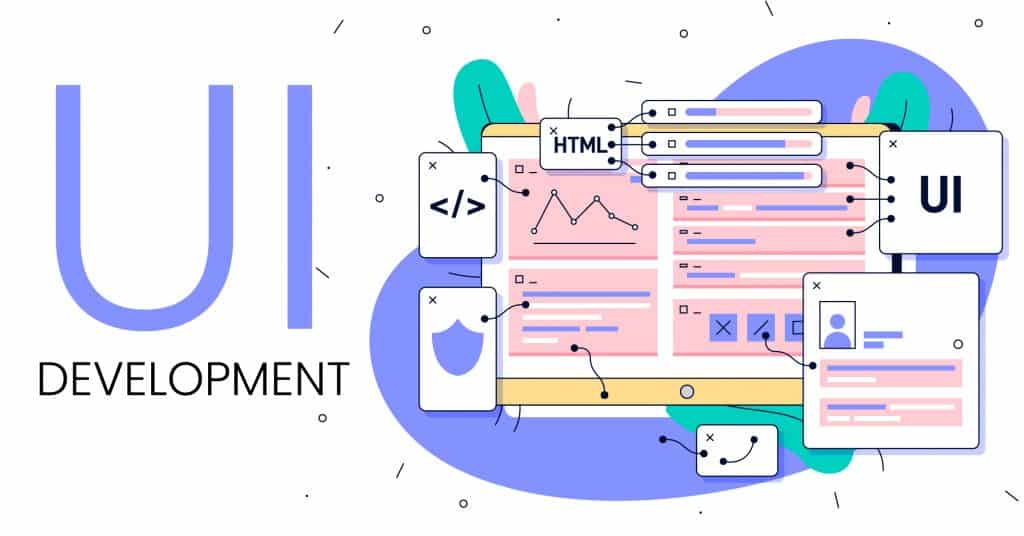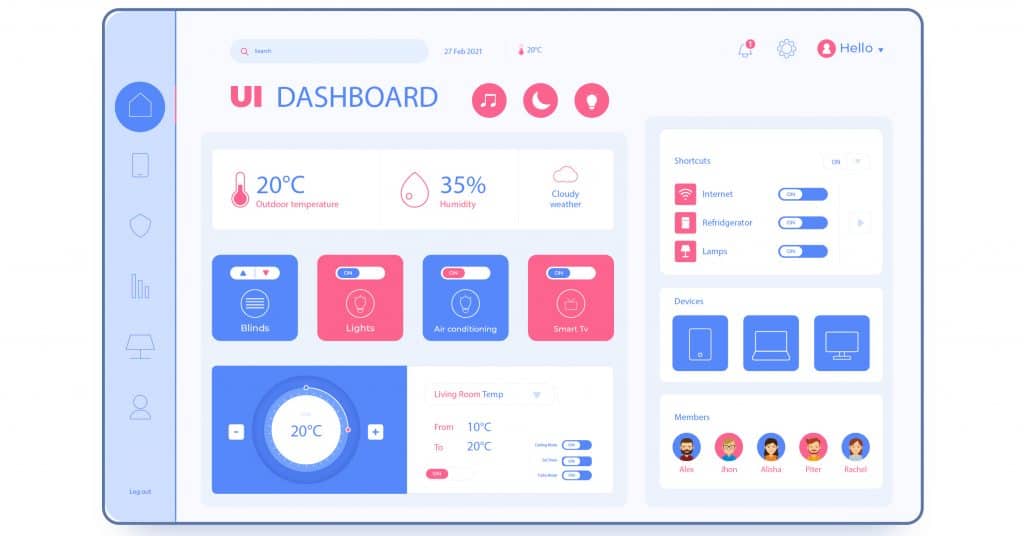FILL OUT THE FORM BELOW & ALLOW US TO TAKE YOUR UI SERVICES TO A WHOLE NEW LEVEL!
UX, IA, and UI services are both abbreviations that may be misleading. In practice, as programmers, we will often be working through these specialisations: designing the overall user experience (UX), arranging information logically as we approach information architecture (IA), and considering the granular nature of the user interface (UI).

Our aim in this phase of the design process is to apply what we have learned to the design of the user interface by:
- A benchmarking is used to generate interface inventories that ensure that your user interface is viewed in a cohesive and consistent manner;
- Creating a patterned library, informed by your design interface, to ensure that the design is economical and usable; and
- Receiving animation as a way to communicate with users improve our build-ups at work and happiness levels.
In short, it is intended to help you develop a systematic approach to addressing the design of the user interface that works best for many projects, and that is questionable. By creating a design framework, we can apply lessons learned from others, thereby improving our designs and resulting in a better outcome for our users.

Get Started With Interface Inventory and UI Services
You can start on a clean slide with a new product or visit an existing product, but it helps to start by creating a creative user interface design. Just as content integration helps to ensure that content (i.e. names, images and other types of content) is consistent, the design interface also ensures that user connections are built consistently within a comprehensive and thoughtful framework.
Spending time in the past will save you a lot of time over time by establishing consistent building programs for all team members and easily intimidating. Creating an innovative interface helps you focus your time and effort on the things you need at this point in time, but – as a style guide – it should be a lively document that expands, grows as your product grows.
When you rearrange an existing product, the design interface begins by marking all your items – no matter how large or small – to be organised. When you start a new project, you may want to map out a competitive product, do a job analysis of others. This helps you to feel the different parts of the interface that you will need to consider.
The first step in this process is to systematically take screenshots of everything you have created. This will take time, but it is important. It is at this stage – especially if you have a large construction team – that you can begin to see inconsistencies in the way various materials are constructed. Your inventory interface will help you identify these items, which you can fix.
Think of all the different features that have a user interface (UI services), including:
Typing
- Topics and Subtitles
- Text Items (Standfirsts, Categories)
- List
Photos and Media
- Symptoms
- Graphics
- Pictures
Forms
- Text input
- Radio / Checkbox Input
- Select menus
The second stage of the process, separating everything, is intended to put some order in the screenshots you have taken. You can edit your screenshots using all sorts of tools, but I suggest you edit everything using Keynote or PowerPoint, so you can bring the task when you’re done to your team.
With the above work done, it’s a good idea to get together as a team or client and use everything. This discussion will lead to a better understanding of the various components you need to design. It can also lead to a certain stream of your unique elements by identifying shared patterns – a big win for efficiency.
Build a Pattern Library
Since the design interface of your interface is done, and all your items are organised, it is important for the UI design agency to start identifying common design patterns and building on them. Your installation of the interface may indicate a good inconsistency in your design; now, the point in the design process is to deal with this by redesigning your UI in a systematic way. This gives a great UI services essence!
Pattern Library identifies and separates design patterns that are repetitive solutions to common design problems. This could be:
- Calendar pickers
- Bread Trails
- Carousels
The pattern library breaks the interface into smaller objects that can be used as renewable building blocks. The benefits of this approach include:
1. Consistency in your design
By creating a complex user interface using small, reusable components, you ensure that all user interface elements are the same because they are all built from the same simple elements.
2. A visual vocabulary that you can share with all team members
By establishing a pattern library for your product, everyone in your team builds to use that as a base instead of building their own ad-hoc content.
3. Working overtime as your designs develop
Even if your product grows over time, it is best to take care of it because it is built on a basic library.
When designing your own interface, it helps to look at the design patterns of others to see what works – and equally – what doesn’t work. Patterns UI is an excellent tool for doing this, to gather a wealth of design patterns.
By using your inventory interface as a starting point for identifying common design patterns, you are one step away from designing the things you need to build to create a design program. This will help ensure that your user interface design services are consistent and scalable.
4. Embracing Atomic Design
We build blocks to create small interface interfaces and combine them to create complex interface elements continuously. The advantages of the atomic design are that you can ensure consistency by combining objects at a granular level and building from these.
Getting The Head Start With The UI Kits
As creative designers – for the most part – on the web, we are fortunate to be part of a community that celebrates the shared approach to our work. We’ve seen the explosion of UI Kits – a well-designed set of user interface material – over the past few years, which helps make our lives a little easier.
There is no point in wasting your time and drawing on common UI objects where the UI Kit can save you this time and effort. A well-designed UI services Kit can create a digital product room stone, be it a website or an app, to ensure it has a consistent look and feels and visual identity.
Adobe has partnered with a series of world-renowned designers to make Adobe XD UI Kits fun, worth checking out. They also provide excellent tutorials on starting your design with UI Kits to make it work.
User interface services are incredibly helpful and can save you a lot of time by saving you from duplicating the most used items. A cautionary note, however, like any standard kit, there is a risk of falling into a template-driven path where one design looks very similar to another. It’s important to use your kit as a starting point, where you layer the look and feel you have created when you create your collages of items.
Design Interaction with Images
One thing that distinguishes the keys between designing a screen and printing is that when we design a screen, we compose the liquid content. This is a critical difference between interactive design and graphic design.
As co-creators, we do not create static pages, and we look at how these pages, and the content of these pages, come together. This is a serious and often overlooked difference by a small group of painters who believe that their role is simply to create sets of pages that will be transferred and ‘stitched together’ by someone technically. ‘
At the risk of releasing ‘designers have to write’ a can of worms that grow endlessly, it is important that the designers working on this technique understand how that process works. For a truly memorable design, it is important that you spend some time learning about the principles of photography. Happily, tools like Adobe XD bring out a lot of code that they had to deal with in the past for immersive performance design.
When designing screens – liquid media – it is important to look at how the user will interact with the design, consider how the change is handled from screen to screen and provide valuable feedback within the user components. We need to look at both large links (page level) and small links (object level).
Getting From A To B
In the past, we may have been moving between screens with little or no animation, limited by the devices we were using at the time. As the processing of power on our desktop and mobile devices has increased, however, the number of opportunities we have been given is immersive in-depth design.
Of course, we need to use this newly acquired power of self-discovery, but the hardware we use for our users now gives us the opportunity to build good connections. That is why we have seen an increase in the interest in prostitution over the past few years. As designers, we respond to the tools we have; as those tools change, so do our designs.
When designing transitions between screens, we need to look at a number of factors, including:
- How to use the user to make the transition from page to page
- What kind of change we use
- How long does the change last
Interacting With Objectives
With our great interaction at the defined page level, it is time to pay attention to small interactions at the object level.
Just as we need to process all the things that add users from page to page, it is also important to pay attention to reducing user interactions with certain things within our pages. This may include buttons, form fields, and other items where intelligent animation can help provide feedback to our users.
Providing visual feedback is very important in building a user-friendly interface: It puts users ’minds at rest by providing a signal that their actions have been approved.
We can improve the design of the user interface through these lessons from the real world to the world of screens. A well-designed visual interface for the user should respond to the user’s actions, letting them know that their actions have the desired effect, putting their mind at ease. This is where animation can play a significant role.
Sites such as the user interface web design provide a wealth of motivation, showing effective examples of animation used in user interactions. It is important to consider how you give the answer and what the situation is, for example:
- When requesting a password, it is helpful to indicate the strength or weakness of the password as the user enters the information (finding out recently that the password is too weak is annoying).
- When a user contacts a button, it helps to provide feedback, notifying the user that his or her actions have been accepted.
- When working with collectors for days and calendars, there is a tangible rate to provide useful feedback.
The above scenarios are just the tip of the iceberg. Wherever your user is asked to share the content on the page, it is an opportunity to consider using cartoons to provide useful feedback.
Finally, it is important to know that animation is not for everyone and can cause – for some people – problems. For users with a vestibular problem, movement can cause dizziness or nausea, so it is important to consider accessibility when using animation.
It would be a good idea to give users a choice, and it’s good to see sites like CodePen World’s Fair warn users about their use of animation and give them the opportunity to continue the site even if they don’t have images. This kind of consideration is great to see: Bravo accessibility!
Choose Thatware As Your UI Service Provider
When designing your interface, it helps to have an operating system. This ensures that whatever you build is considered and does not agree. Starting with the introduction of the interface – especially if you revisit an existing product as part of a reconstruction – will help you identify points where your interface needs to work. Over time, it is only natural that inconsistencies can develop UI services; this tool provides a good way to identify this.
When it’s time to build your interface, spend some time developing a thoughtful plan; this not only ensures that your design is consistent but also helps keep your team on the same page and provides any freelancers working on the project with all the instructions they need in one central location.
Lastly, it is important to look at the structure of your interactions with animation. As designers working on screens, it is important that we consider how our design responds to user interaction. After all, we are building something immeasurable; let’s use that softness in our favour! By combining all of the above together, you will have the basics of a solid user experience that will stand the test of time.


